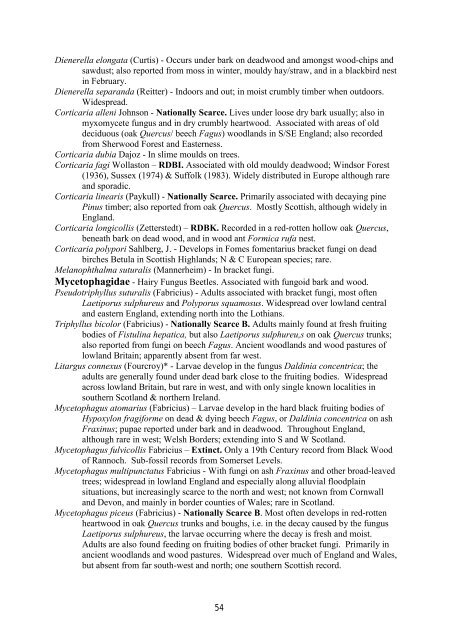Crustacea: Copepoda - Cerambycoidea.com
Crustacea: Copepoda - Cerambycoidea.com
Crustacea: Copepoda - Cerambycoidea.com
Create successful ePaper yourself
Turn your PDF publications into a flip-book with our unique Google optimized e-Paper software.
Dienerella elongata (Curtis) - Occurs under bark on deadwood and amongst wood-chips and<br />
sawdust; also reported from moss in winter, mouldy hay/straw, and in a blackbird nest<br />
in February.<br />
Dienerella separanda (Reitter) - Indoors and out; in moist crumbly timber when outdoors.<br />
Widespread.<br />
Corticaria alleni Johnson - Nationally Scarce. Lives under loose dry bark usually; also in<br />
myxomycete fungus and in dry crumbly heartwood. Associated with areas of old<br />
deciduous (oak Quercus/ beech Fagus) woodlands in S/SE England; also recorded<br />
from Sherwood Forest and Easterness.<br />
Corticaria dubia Dajoz - In slime moulds on trees.<br />
Corticaria fagi Wollaston – RDBI. Associated with old mouldy deadwood; Windsor Forest<br />
(1936), Sussex (1974) & Suffolk (1983). Widely distributed in Europe although rare<br />
and sporadic.<br />
Corticaria linearis (Paykull) - Nationally Scarce. Primarily associated with decaying pine<br />
Pinus timber; also reported from oak Quercus. Mostly Scottish, although widely in<br />
England.<br />
Corticaria longicollis (Zetterstedt) – RDBK. Recorded in a red-rotten hollow oak Quercus,<br />
beneath bark on dead wood, and in wood ant Formica rufa nest.<br />
Corticaria polypori Sahlberg, J. - Develops in Fomes fomentarius bracket fungi on dead<br />
birches Betula in Scottish Highlands; N & C European species; rare.<br />
Melanophthalma suturalis (Mannerheim) - In bracket fungi.<br />
Mycetophagidae - Hairy Fungus Beetles. Associated with fungoid bark and wood.<br />
Pseudotriphyllus suturalis (Fabricius) - Adults associated with bracket fungi, most often<br />
Laetiporus sulphureus and Polyporus squamosus. Widespread over lowland central<br />
and eastern England, extending north into the Lothians.<br />
Triphyllus bicolor (Fabricius) - Nationally Scarce B. Adults mainly found at fresh fruiting<br />
bodies of Fistulina hepatica, but also Laetiporus sulphureu,s on oak Quercus trunks;<br />
also reported from fungi on beech Fagus. Ancient woodlands and wood pastures of<br />
lowland Britain; apparently absent from far west.<br />
Litargus connexus (Fourcroy)* - Larvae develop in the fungus Daldinia concentrica; the<br />
adults are generally found under dead bark close to the fruiting bodies. Widespread<br />
across lowland Britain, but rare in west, and with only single known localities in<br />
southern Scotland & northern Ireland.<br />
Mycetophagus atomarius (Fabricius) – Larvae develop in the hard black fruiting bodies of<br />
Hypoxylon fragiforme on dead & dying beech Fagus, or Daldinia concentrica on ash<br />
Fraxinus; pupae reported under bark and in deadwood. Throughout England,<br />
although rare in west; Welsh Borders; extending into S and W Scotland.<br />
Mycetophagus fulvicollis Fabricius – Extinct. Only a 19th Century record from Black Wood<br />
of Rannoch. Sub-fossil records from Somerset Levels.<br />
Mycetophagus multipunctatus Fabricius - With fungi on ash Fraxinus and other broad-leaved<br />
trees; widespread in lowland England and especially along alluvial floodplain<br />
situations, but increasingly scarce to the north and west; not known from Cornwall<br />
and Devon, and mainly in border counties of Wales; rare in Scotland.<br />
Mycetophagus piceus (Fabricius) - Nationally Scarce B. Most often develops in red-rotten<br />
heartwood in oak Quercus trunks and boughs, i.e. in the decay caused by the fungus<br />
Laetiporus sulphureus, the larvae occurring where the decay is fresh and moist.<br />
Adults are also found feeding on fruiting bodies of other bracket fungi. Primarily in<br />
ancient woodlands and wood pastures. Widespread over much of England and Wales,<br />
but absent from far south-west and north; one southern Scottish record.<br />
54

















